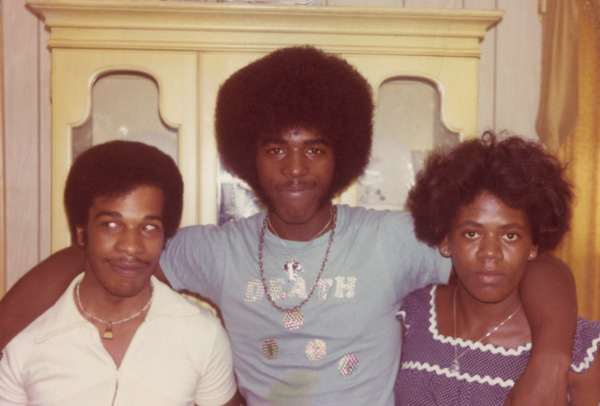The road to rock ‘n’ roll fame is littered with failed bands, but the tale of A Band Called Death grabs attention for its unusual angle: the intersections of inspiration, race, faith, family, and very loud beats.
Detroit is central to the engaging story of the Hackney brothers, where the booming car factories helped African Americans build the American dream, and where their religious parents could indulge teenage sons, Bobby, Dannis, and David, their wish to imitate the British bands they watched together on The Ed Sullivan Show. The gritty city was a cauldron of raucous rock innovation in the late 1960’s, including the MC-5 (MC as in Motor City), the Stooges, and Alice Cooper. Seeing the latter live fired up David in 1971 to get a guitar and convinced Dannis to bang on a set of drums and Bobby to experiment with a bass guitar. But Motown dominated the local scene. Their oldest (non-musical) brother Earl remembers, with a belly laugh now, mocking them for playing “white boy music.” In their old neighborhood, folks remember running outside to protest the racket they were making.
With that sense of us against them, David swore them to a pact, to “back your brother,” which became more pronounced when their father was killed in a tragic accident and David became more obsessed with spirituality and a sense of destiny. He announced he had picked a triangular logo for their band and a provocative name that fit the songs he was writing—Death. By 1975, David felt brash enough to target a music publisher, who was intrigued enough to record a demo. A studio executive recalls the piles of rejection letters he got from record labels, until the legendary music producer Clive Davis, who had signed such acts as Bruce Springsteen and Aerosmith at CBS Records, was interested—but only if the band would change its name. The brothers emotionally relate how David refused to compromise his creative and political vision, and took back their masters to produce a very contemporary DIY release of 500 seven-inch singles for DJs and record stores.
The images of Detroit’s decay parallel the busting of the brothers’ hopes and finances as the record generated zero interest. For the first time, when they resettled in bucolic Vermont, the brothers broke ranks, and a bitter David insisted on one last promise—to save their recordings until they could be appreciated in the future. And they sat in an attic for almost three decades, forgotten and unmentioned to the rest of the family, as David succumbed to alcohol back in Detroit, sorrowfully described by his widow. The much more philosophically resigned Dannis and Bobby creatively reinvented themselves through a Christian reggae band Lambsbread (they both now have long dreads), and encouraged their sons to start their own rock bands.
Fast forward to the world of the future, when Vernon Reid’s Black Rock Coalition champions broader perceptions for African Americans in rock ‘n’ roll beyond Jimi Hendrix. And on the Internet, obsessed record collectors (such as Jello Biafra), DJs, and fans of the eclectic and unknown find each other, and then those few singles start popping up for over $800 on eBay. (There are some parallels to last year’s Searching for Sugar Man where coincidences reignited a career.) While directors Mark Covino and Jeff Howlett make a bit too much of the band as punk innovators, several years before the Ramones, Death’s loud, fast, and angry tracks still sound amazingly fresh. The surviving brothers’ good spirits and storytelling are as infectiously appealing as their punk rock seems to be a fountain of youth.







Leave A Comment